While the Berlin Marathon is a Major event, it’s the city’s rich history that truly makes it unique
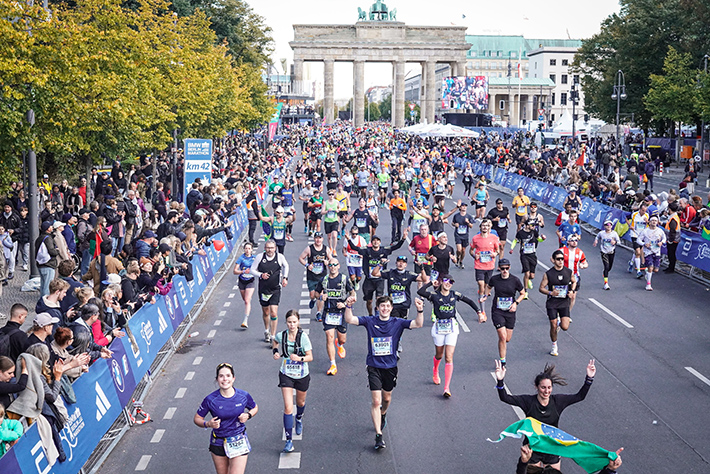
The final meters of the 50th Berlin Marathon, with the iconic Brandenburg Gate in the backdrop (Sportograf)
What shaped the Berlin Marathon over its 50-year history goes beyond being a Major race. The 42.195 km race in the German capital is far more than just a part of the Abbott World Marathon Majors, an elite circuit launched in 2006 that also features marathons in Tokyo (Japan), Boston (US), London (England), Chicago (US), and New York (US). The BMW Berlin Marathon would still hold immense significance even if it weren’t part of the circuit. What makes the Berlin Marathon truly special is the city itself—Berlin, once divided and separated by a wall from 1961 to 1989, but later reunited, just like Germany.
In 1990, just three days before Germany’s official reunification, athletes crossed the Brandenburg Gate in East Berlin for the first time and stood by the wall. Before 1989, the event had only taken place in West Berlin, with the wall preventing runners from reaching the Gate. Approximately 25,000 people participated in the 1990 edition, the 17th Berlin Marathon. Amidst the political transition, this edition demonstrated that the Berlin Marathon would have a grand and historic role for the nation, even before becoming part of the Major series.
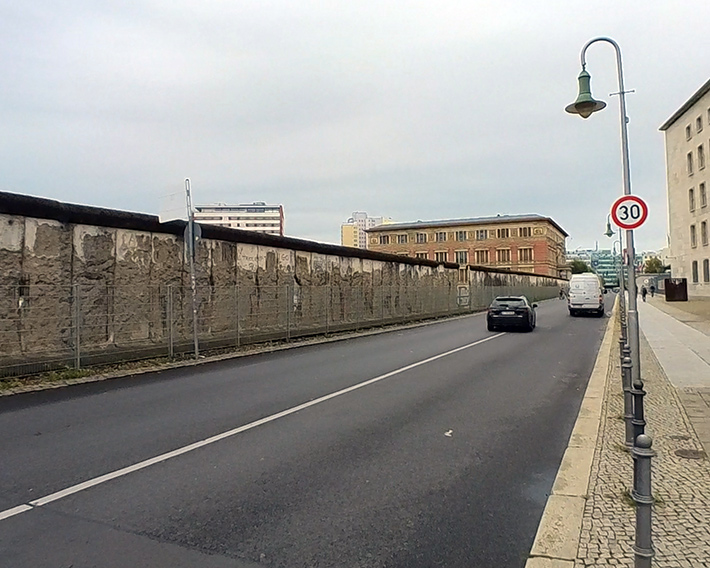
Memory: remnants of the Berlin Wall are still visible in certain parts of the city (Esportividade)
The Berlin Marathon embodies the freedom of movement, a right denied for nearly three decades during the 20th century. This freedom is reaffirmed every year as athletes from all corners of the world run through the Brandenburg Gate unhindered by walls. However, the city’s history remains visible: remnants of the wall can still be found in some areas. Cobblestones trace the wall’s original path in certain places, serving as a reminder of the past.
In 2024, the Berlin Marathon marked two significant milestones: 50 years of history and 50 editions, as the 2020 race was canceled due to the COVID-19 pandemic. This occasion set a new record for attendance: 54,280 people completed the 42.195 km race, making it the largest marathon in history (as of September 2024) in terms of medal finishers. Among them were over 1,600 Brazilians, representing nearly 3% of the total participants, almost identical to 2023.
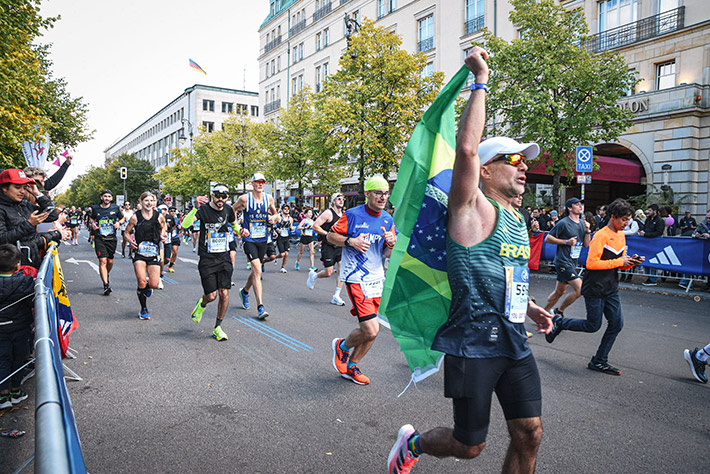
Brazil: proudly represented by a large number of runners in the 50th Berlin Marathon (Sportograf)
Although there are no direct flights from São Paulo or Rio de Janeiro to Berlin, reaching the German capital is still quite convenient. Runners have two main options: they can fly to other European cities like Lisbon, Paris, or Amsterdam and catch a connecting flight to Berlin, or they can fly to Frankfurt and take the high-speed train to Berlin. This train travels at over 250 km/h, allowing passengers to arrive at Berlin Hauptbahnhof, the city’s central station, after a four-to five-hour journey.
Although most Brazilians don’t speak German, there are many ways to communicate and get assistance. Many service providers speak English, and mobile apps offer helpful tools for visitors, including simultaneous translation and maps in Portuguese, making it easier for people to navigate and reach their destinations.
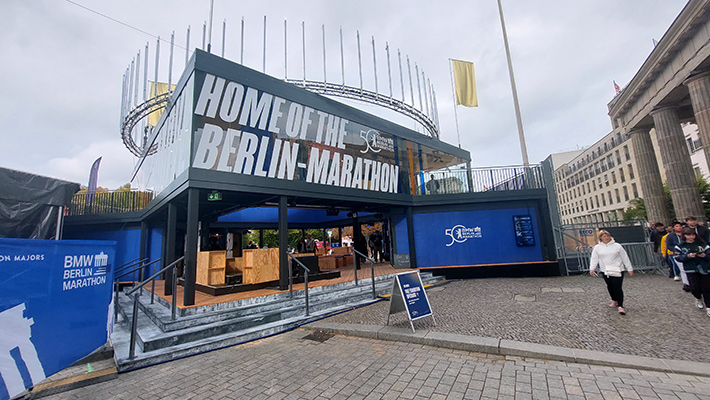
A Berlin Marathon booth near the iconic Brandenburg Gate (Esportividade)
Berlin’s public transportation system is highly efficient, often providing two or three options to reach the same destination. Marathon participants received a voucher that granted them free access to Berlin’s public transportation from Thursday, September 26, 2024, through the early hours of Monday, September 30. Berlin’s public transportation system has no turnstiles to control entry or payment. Instead, agents occasionally conduct spot checks to ensure passengers have valid tickets.
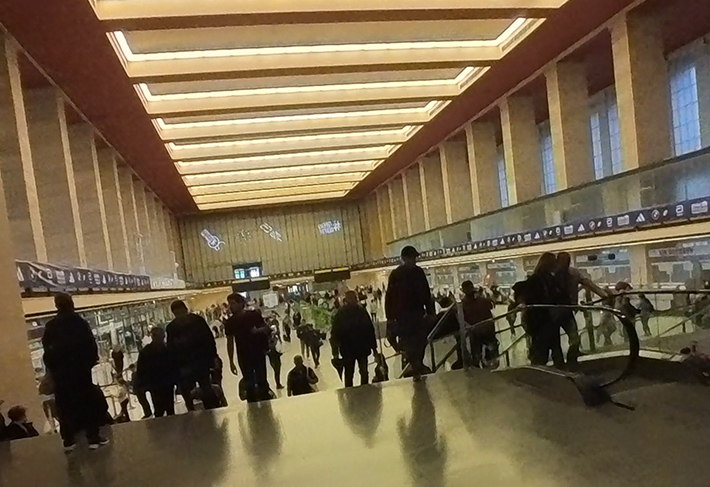
Entrance and exit of the Marathon Expo. The lobby of the former Berlin-Tempelhof Airport served as the venue for this event (Esportividade)
On Thursday morning, Berlin was already buzzing with marathon excitement. More runners were spotted training in the streets, and the temporary booth near the Brandenburg Gate, showcasing an exhibition on the event’s history, grew busier with participants and their companions. At 3 p.m. on Thursday, “boarding” was officially allowed. Race kits were being distributed at the former Berlin-Tempelhof Airport, which was decommissioned in 2008 and now serves as a municipal park. The biggest draw of the Marathon Expo is undoubtedly its unique location.
Check out a brief video of the bib number collection:
Ver essa foto no Instagram
Given the large number of participants, there was a long queue, as expected. However, the wait was far from dull, as the line moved quickly. After the pre-screening, runners didn’t spend much time in the designated areas, where they had to put on their wristbands (to be worn until Sunday) and collect their bib numbers. The longest queue was at the checkout of the adidas store, the event’s sponsor, organized by SCC.
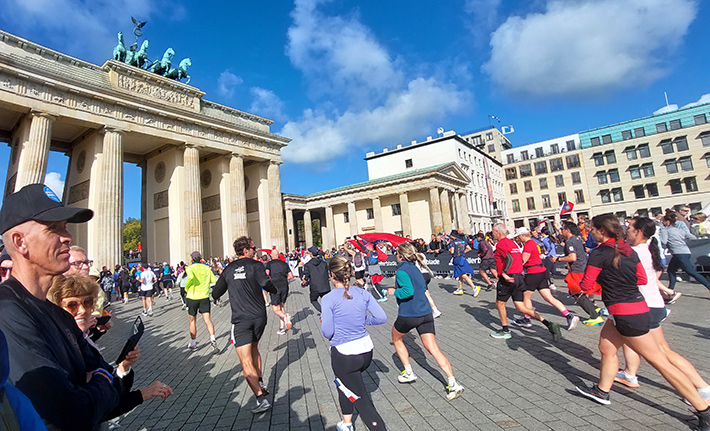
Athletes making their way toward the Brandenburg Gate during the Generali 5k (Esportividade)
Those who picked up their race kits on Thursday could enjoy a relaxed Friday, free from marathon preparations, allowing them time to rest or leisurely explore some of Berlin’s tourist attractions. In 2024, the traditional collective training session was transformed into a race to celebrate the 50th anniversary. Held at Potsdamer Platz and sponsored by the insurance company Generali, the 5 km race started at 10 a.m. and offered an opportunity for the families of marathon runners to participate. Hundreds of athletes who would be competing on Sunday also attended the event. Participants of the 5 km race also experienced the thrill of crossing the iconic Brandenburg Gate right before receiving their medals.
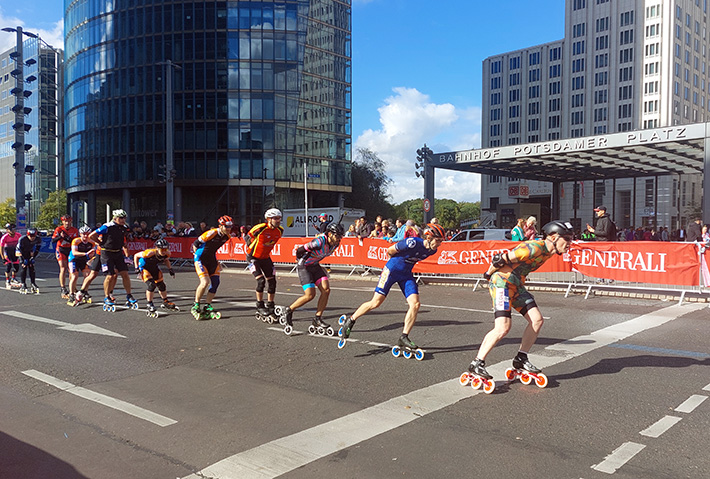
Skaters gliding past Potsdamer Platz station (Esportividade)
The conclusion of the 5 km race wasn’t the end of the sports-filled Saturday. There were also children’s races at Potsdamer Platz and the famous inline skating marathon—a 42.195 km race, with much of it taking place on a 7 km circuit completed over five laps. The final stretch, outside the loop, aligned with the course for Sunday’s marathon. Fourteen Brazilians took part in the inline skating race.
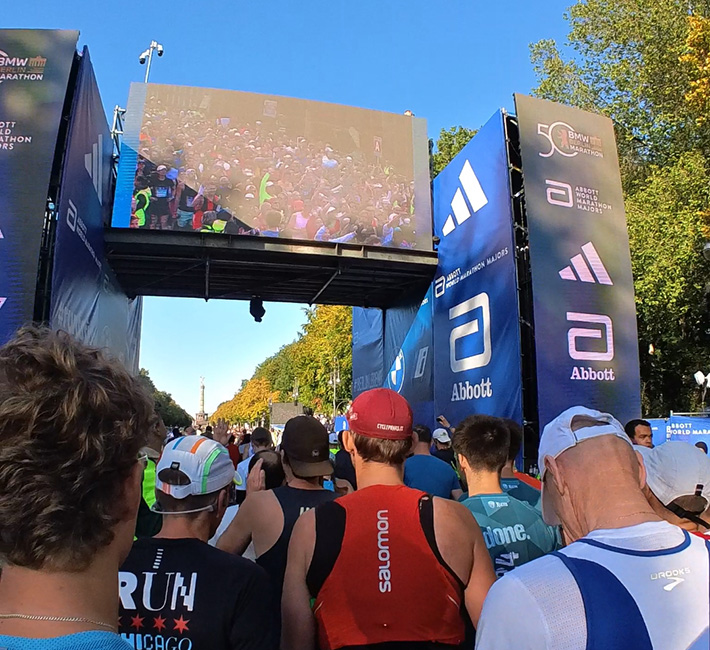
Moments before crossing the start line and beginning the race in Berlin (Esportividade)
The long-awaited 50th Berlin Marathon Sunday has finally arrived! No matter which station or bus stop you found yourself at, you’d encounter someone sporting a race bib, heading towards Tiergarten Park, just a few meters away from the Brandenburg Gate. Since the race started in waves, participants didn’t all arrive at the “arena” simultaneously. Despite the large crowd, the lines moved swiftly once again. Due to the chilly weather, ranging between 8°C and 10°C, participants wore sweaters or plastic coverings until just minutes before the race began, leaving them on the median strip to be collected by organizers and later donated.
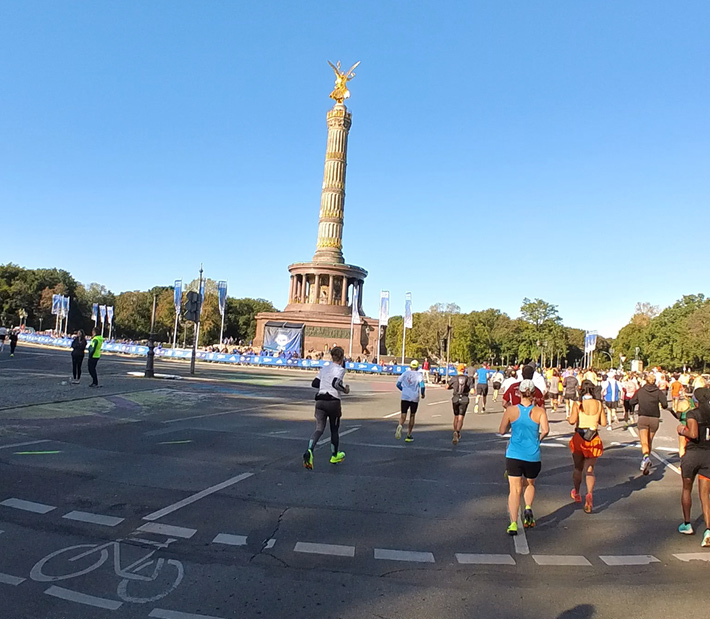
The Victory Column is seen at the first kilometer of the Berlin Marathon (Esportividade)
The Brazilians in the second wave were thrilled to hear the song “Sorte Grande” by Ivete Sangalo, a track that has become a tradition at the Berlin Marathon. As soon as they were allowed to start, they realized how fortunate they were when they caught sight of the Victory Column (Siegessäule), an obelisk standing at the center of a large circular square.
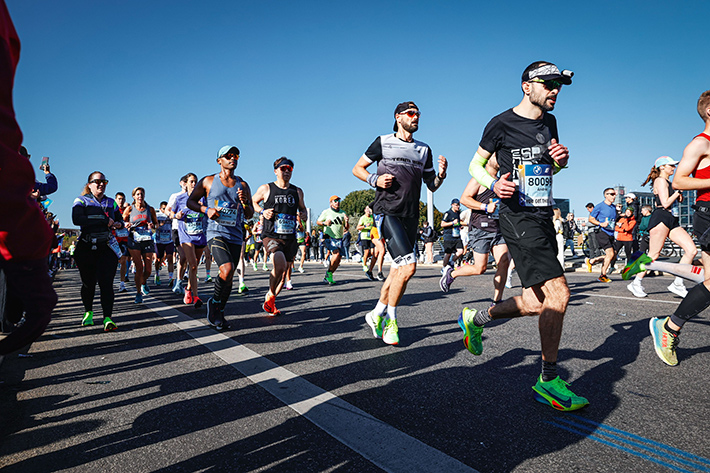
Andrei (80099) runs the 50th Berlin Marathon: the race has a smooth and steady flow (Sportograf)
After the initial stretch, when one group of runners veered left and another to the right, a massive pack of participants quickly formed. Contrary to what one might expect, the runners maintained a reasonably consistent pace, indicating they respected their starting block positions. As a result, there was a sense of being part of a continuous flow, which enhanced the overall quality of the race. Also, runners could maintain a steady pace as they encountered no significant climbs.
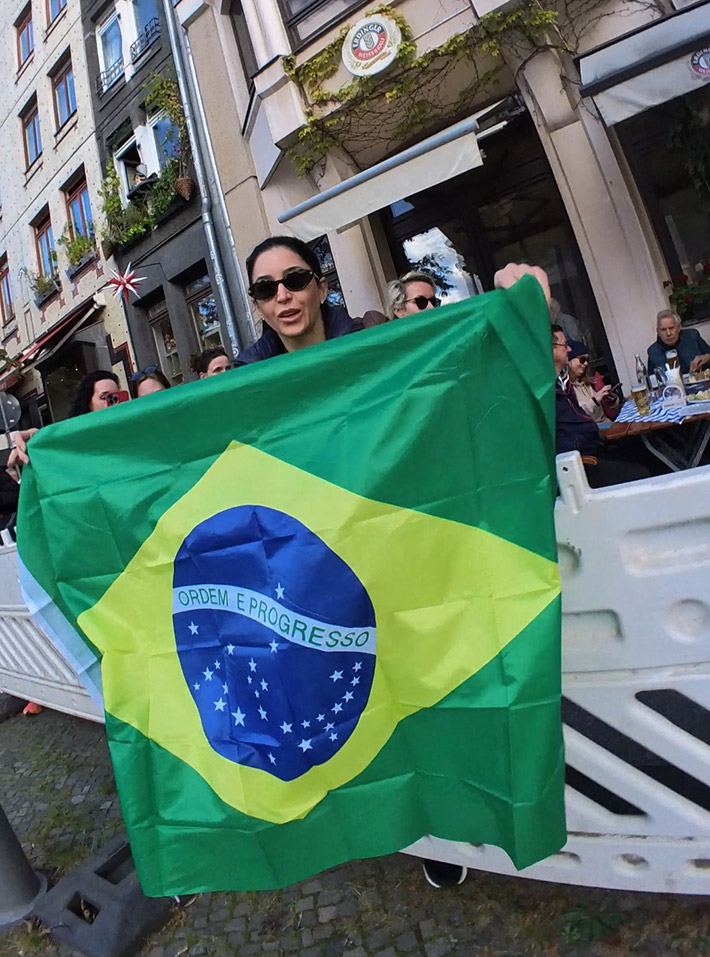
A Brazilian supporter waves a Brazilian flag (Esportividade)
Like other European marathons, large crowds of spectators gathered to cheer on the runners. While some spectators were locals, many were friends and family members of the participants. They waited for their loved ones to pass by, often waving their national flags, including those of Brazil.
Check out this short video highlighting the vibrant Brazilian presence at the 2024 Berlin Marathon:
Ver essa foto no Instagram
With three out of every hundred participants being Brazilian and most wearing T-shirts from sports organizations or in Brazil’s colors, they were easy to spot during the race, making brief interactions simple.

A child supporting runners during the 50th BMW Berlin Marathon (Esportividade)
One Brazilian amateur athlete lent a helping hand to another. Foreigners also displayed empathy, offering a supportive tap on the shoulder to fellow athletes when they noticed someone was struggling. And local supporters contributed to the atmosphere as well.
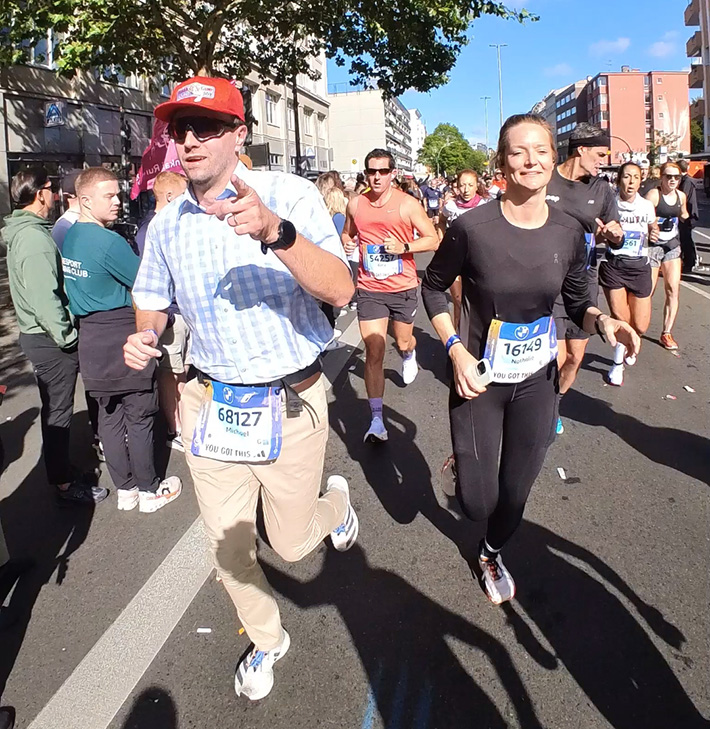
The blue line also serves as a guide for Forrest Gump (Esportividade).
The blue line on the ground marking the route served as a reference point for the athletes, particularly as they approached a turn. Water stations and portable toilets were conveniently placed along the path in ample quantities. Timing mats placed every 5 kilometers recorded each participant’s split time, providing real-time updates for those tracking their performance through the app.

After passing through the Gate, runners make their way to the finish line (Sportograf)
Other big European marathons, including those in Vienna, Copenhagen, Frankfurt, and Barcelona, also feature these elements. The Vienna Marathon provided more opportunities for participant interaction than the Berlin Marathon, featuring a large screen that displayed audio and video messages from friends and family during the race. In terms of organization, Berlin is on par with the others, maintaining the same high standards.
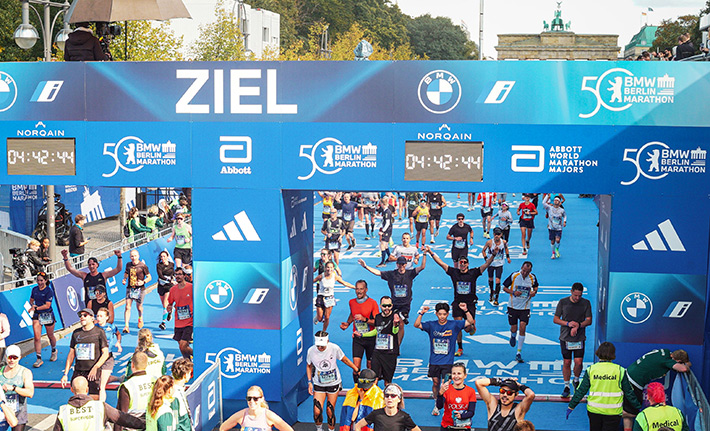
Finish line at the 50th Berlin Marathon (Sportograf)
The remarkable aspect of the Berlin race lies in its history, and the finish of the 50th edition was indeed one of the most incredible experiences in the world. As runners approached the final stretch, gazing at the Brandenburg Gate, they felt empowered to give it their all, pushing their limits, regardless of whether they would achieve personal bests. Two unforgettable moments in just over 200 meters: passing through the gate and crossing the finish line.

Andrei Spinassé proudly displays his medal from the 50th Berlin Marathon (Esportividade)
After receiving the stunning 50th thematic medal, the Brazilian runners gathered with their compatriots to discuss the race. They enjoyed bananas, hot tea, cold non-alcoholic beer, and thermal ponchos, rang the bell to celebrate personal records, recorded their times on the medals (if they had arranged that in advance), took some time to rest in Tiergarten Park or Republic Square, and then headed back to their accommodations.
On Sunday night and Monday morning, the German capital was still buzzing with marathon runners, proudly displaying their medals and wearing event jackets or T-shirts, even at Berlin Hauptbahnhof, as they continued their journeys.

An athlete dressed as the Brandenburg Gate participated in the 2024 Berlin Marathon (Esportividade)
Due to its competitive nature, there is an annual registration lottery, which costs 200 euros. Those interested in running in the 2025 edition, scheduled for September 21, can already register (click here) and await the draw.
Esportividade’s coverage of the 50th edition of the Berlin Marathon (2024) was made possible with the support of visitBerlin and ClassPass.
See also (in Portuguese):
Edição 50 da Maratona de Berlim: nova experiência marcante em prova de 5 km
Passeio de barco permite conhecer Berlim e onde praticar corrida na capital alemã
